The Bagasse Disposable Cutlery Market is estimated to be valued at USD 612.3 million in 2025 and is projected to reach USD 1,238.6 million by 2035, registering a compound annual growth rate (CAGR) of 7.3% over the forecast period.
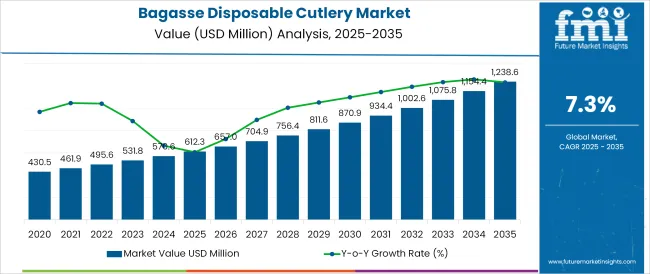
The bagasse disposable cutlery market is witnessing sustained momentum as environmental regulations, consumer preferences, and corporate ESG goals converge toward eco-friendly alternatives to plastic. Bagasse, a by-product of sugarcane processing, has gained traction as a biodegradable and compostable material aligned with circular economy practices.
Governments worldwide are implementing bans on single-use plastics, creating a regulatory push for sustainable disposables in both retail and foodservice sectors. Manufacturers are scaling production capacities and investing in product innovation to enhance durability, heat resistance, and aesthetic appeal. The shift toward takeout, food delivery, and quick-service models has also fueled demand for compostable cutlery, particularly in urban centers.
Emerging markets are witnessing adoption via hospitality and institutional sectors, while mature markets are embracing private-label offerings and bulk procurement. Future growth is expected to be driven by innovations in hybrid bio composites, cost optimization, and wider distribution through organized retail and e-commerce.
The market is segmented by Product, End-User, and Sales Channel and region. By Product, the market is divided into Spoon, Fork, and Knife. In terms of End-User, the market is classified into Commercial Use, Hotels & Cafes, Full Service Restaurants, Quick Service Restaurants, Venues & Catering, Mobile Food Vendors, Bakery & Patisserie, Institutional Use, Schools & Colleges, Offices, Hospitals, Airport & Railways, and Household Use.
Based on Sales Channel, the market is segmented into Departmental & Discount Stores, Hypermarket/Supermarket, Specialty Stores, and Online Sales. Regionally, the market is classified into North America, Latin America, Western Europe, Eastern Europe, Balkan & Baltic Countries, Russia & Belarus, Central Asia, East Asia, South Asia & Pacific, and the Middle East & Africa.
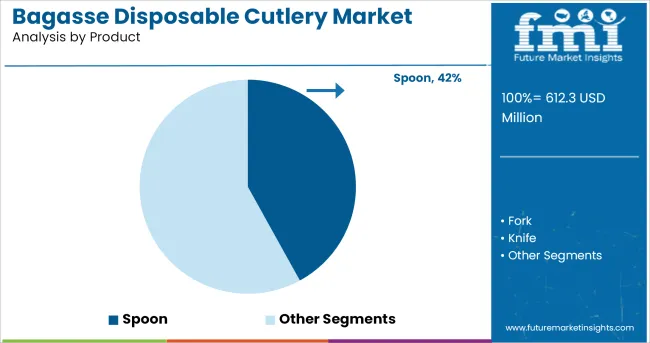
The spoon category is anticipated to account for 42.0% of total revenue within the product segment in 2025, establishing it as the leading product type. This segment’s dominance stems from its widespread utility across various food types and consumption settings, including desserts, soups, and ready to eat meals.
Its ergonomic design and high frequency of use in single-serve and takeaway applications have made spoons a core component of disposable cutlery kits. The adoption of bagasse as a material for spoons has increased due to its moldability and ability to retain structure under heat, making it a favorable alternative to plastic.
Manufacturers have optimized production lines to meet bulk demand from the foodservice industry, further boosting supply chain efficiency. Retail and institutional buyers alike prioritize spoons due to their consistent demand, contributing to their leadership position in the bagasse cutlery product lineup.
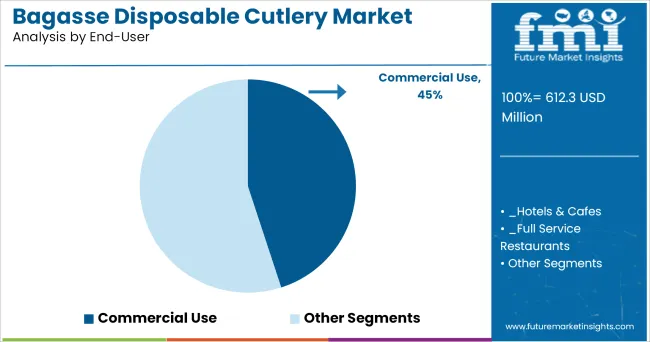
Commercial end users are projected to hold 45.0% of the total revenue share in 2025, making this the dominant segment in terms of consumption. This is attributed to increased adoption of eco-friendly disposables by restaurants, cafeterias, hotels, catering services, and quick service outlets that are seeking alternatives to plastic utensils.
Regulatory mandates and public sustainability expectations have pressured commercial operators to transition toward compostable solutions like bagasse cutlery. In addition to environmental compliance commercial buyers are focused on consistency in quality, cost efficiency in bulk procurement, and compatibility with high-volume service environments
Institutional contracts, government-run food programs, and hospitality chains are also contributing to demand by incorporating bagasse cutlery into their sustainable procurement frameworks. As consumer demand for ethical and environmentally conscious dining rises, commercial use is expected to remain the largest and most consistent demand driver in the market.
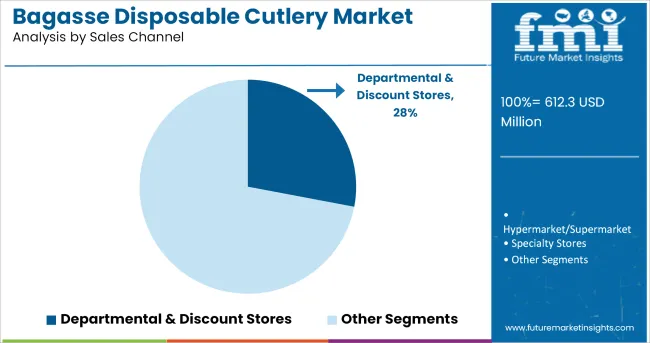
The departmental and discount store channel is projected to contribute 28.0% of overall market revenue in 2025, leading among offline retail formats. This segment has gained prominence due to the increased visibility and accessibility it provides to cost-sensitive and sustainability-conscious consumers.
Departmental stores have expanded shelf space for eco-friendly kitchenware and dining essentials, often highlighting biodegradable certifications and private-label offerings. Discount retailers appeal to a wide demographic, offering bagasse cutlery in multi-pack and family-size formats at competitive pricing, further driving unit sales.
Offline presence also supports impulse buying and product trials, especially in urban and semi-urban regions where online penetration is moderate. As consumers continue to prioritize convenience, affordability, and sustainability in purchase decisions, departmental and discount stores are expected to remain a vital sales avenue for disposable bagasse cutlery.
Bagasse Disposable cutlery is a recycled, biodegradable, eco-friendly products that is manufactured using bagasse material. Bagasse is the fibrous material which remains after the juices are removed from the sugarcane stalk.
Bagasse disposable cutlery includes a spoon, fork and knife. Reusable spoons, knives, forks are the most common variants available in the market. In comparison to plastic-based product, Bagasse disposable cutlery cause nominal pollution and produce slight waste.
Increasing awareness of consumers concerning the harmful impact of non-recyclable cutlery usage is one of the key aspects which drives the growth of the bagasse disposable cutlery market.
To capitalize on the growing demand for bagasse disposable cutlery, manufacturers in the cutlery market are expanding their manufacturing facilities, while obtaining local colleagues to gain a competitive edge. Overall, the global outlook for bagasse disposable cutlery market is projected to continue enlightened during the forecast period.
In recent times, the bagasse disposable cutlery market has observed a shift in demand for recyclable disposable cutlery composed of bagasse. Due to constant regulations, numerous food & beverage chains have started serving food in eco-friendly, disposable cutlery which is creating opportunities for bagasse cutlery manufacturers to tap.
To promote green practices some manufacturers have substituted plastic cutlery with bagasse cutlery which leads to the growth of the bagasse disposable cutlery market.
In an emerging market, due to increasing income, shifting routines, and fast urbanisation there is an expansion in consumer preference for takeaways or ready-to-eat food. The corporate work culture contributing to out-of-home eating habits is strengthening the market for bagasse disposable cutlery for food service.
When peoples have busy work schedules it leads to demand for easy-to-use or bagasse disposable cutlery, which does not require to be cleaned which leads to an important growth factor in the bagasse disposable cutlery market.
As a new social trend, bagasse disposable cutlery is considered as a feasible alternative that provides the suitability of disposable cutlery at parties and on other occasions, along with an additional advantage of nominal harmful effect on the environment.
Furthermore, there is an increase in hygiene standards, which has increased the global bagasse disposable cutlery consumption and is expected to gain new heights during the forecast period.
Nowadays, cutlery market is gaining more traction among consumers due to the increasing consumption of cutlery in restaurants, hotels and other fast restaurants. The availability of different materials in cutlery such as glass, paper, plastic and others is expected to hinder the growth of bagasse disposable cutlery market.
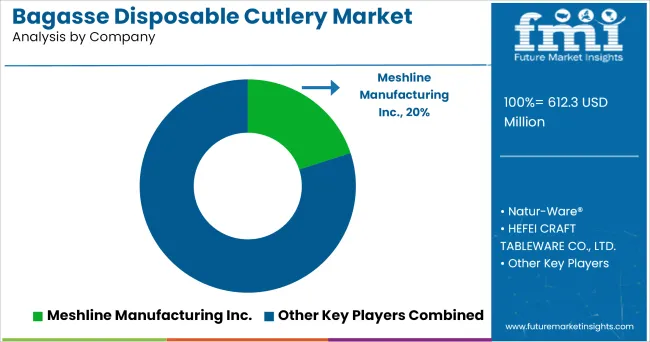
Global Products:
Asian Players:
The key players adopt various strategies such as product launch, merger & acquisition, innovation and others to survive the competition in the market. Key players are launching new and innovative bagasse disposable cutlery in the market to lure a major portion of the end-users and manufacturers.
In September 2020, Herald Plastic launched the new bagasse range that includes square, round and rectangle plates and cutler in different sizes, bowls and hot boxes.
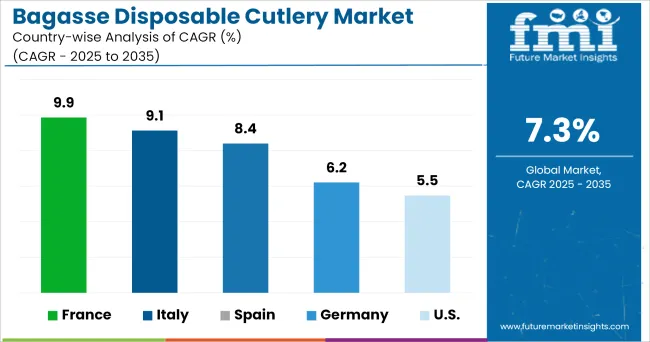
Germany is expected to witness growth in the forecast period with rapid and continuous growth in the bagasse disposable cutlery market share with the rising demand for the food & beverage industry. Also, continuous developments and upgrades in the technology in the food & beverage industry are expected to gain huge demand for the bagasse disposable cutlery market.
Due to the involvement of foreign and small players, restaurants that are operating in the country is highly fragmented in the bagasse disposable cutlery market. Overall growth in the bagasse disposable cutlery market in Germany is increasing opportunities as well as demand.
The global bagasse disposable cutlery market is estimated to be valued at USD 612.3 million in 2025.
The market size for the bagasse disposable cutlery market is projected to reach USD 1,238.6 million by 2035.
The bagasse disposable cutlery market is expected to grow at a 7.3% CAGR between 2025 and 2035.
The key product types in bagasse disposable cutlery market are spoon, fork and knife.
In terms of end-user, commercial use segment to command 45.0% share in the bagasse disposable cutlery market in 2025.






Full Research Suite comprises of:
Market outlook & trends analysis
Interviews & case studies
Strategic recommendations
Vendor profiles & capabilities analysis
5-year forecasts
8 regions and 60+ country-level data splits
Market segment data splits
12 months of continuous data updates
DELIVERED AS:
PDF EXCEL ONLINE
Examining Market Share Trends in Bagasse Disposable Cutlery
Bagasse Tableware Products Market Size and Share Forecast Outlook 2025 to 2035
Bagasse Bowls Market Size and Share Forecast Outlook 2025 to 2035
Market Share Insights for Bagasse Bowls Providers
Understanding Market Share Trends in Bagasse Packaging
Market Share Insights of Bagasse Tableware Product Providers
USA Bagasse Tableware Products Market Outlook – Size, Trends & Forecast 2025-2035
ASEAN Bagasse Tableware Products Market Insights – Growth, Demand & Forecast 2025-2035
Japan Bagasse Tableware Products Market Outlook – Size, Trends & Forecast 2025-2035
Germany Bagasse Tableware Products Market Outlook – Size, Trends & Forecast 2025-2035
Demand and Trend Analysis of Bagasse Tableware Product in Japan Size and Share Forecast Outlook 2025 to 2035
Demand and Trend Analysis of Bagasse Tableware Product in Korea Size and Share Forecast Outlook 2025 to 2035
Western Europe Bagasse Tableware Market Analysis – Growth & Forecast 2023-2033
Disposable Medical Gowns Market Size and Share Forecast Outlook 2025 to 2035
Disposable Drills Market Size and Share Forecast Outlook 2025 to 2035
Disposable Food Containers Market Size and Share Forecast Outlook 2025 to 2035
Disposable Protective Apparel Market Size and Share Forecast Outlook 2025 to 2035
Disposable Plates Market Size and Share Forecast Outlook 2025 to 2035
Disposable Hygiene Adhesives Market Size and Share Forecast Outlook 2025 to 2035
Disposable Umbilical Cord Protection Bag Market Size and Share Forecast Outlook 2025 to 2035

Thank you!
You will receive an email from our Business Development Manager. Please be sure to check your SPAM/JUNK folder too.
Chat With
MaRIA